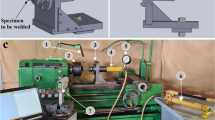Abstract
In this study, K30 (W 90 wt%, Co 10 wt%) and DX5 (W 84 wt%, Co 16 wt%) tungsten carbide were used as base metals for transient liquid-phase diffusion bonding (TLPDB). The filler metal was MBF20, a type of nickel alloy used to minimize the residual stresses that occur due to the differences in the expansion coefficients of the metals. MBF20 contained B, Si, and Cr, which reduced the melting point of the nickel alloy and enhanced its mechanical properties. The base metal and filler metal surfaces were cleaned by mechanical polishing and cleaning. Diffusion bonding was performed under vacuum at 1,000–1,500 K under low pressure than buckling load conditions. The microstructure on the localized bonded surface was analyzed using scanning electron microscope (SEM) and optical microscopy. Result of no significant change was observed in the diffusion bonding in the low-to-mid temperature range due to insufficient filler metal or base metal dissolution at the bonding site. However, at high temperatures, the filler completely melted and bonded to the base metal on both sides. Our results showed that temperatures approaching the recrystallization temperature were required to provide high-quality welds for ultra-precision joints and micro polycrystalline diamond (PCD) tool fabrication.
Similar content being viewed by others
References
C. Y. Kang, On the transient liquid phase diffusion bonding, Journal of the Korean Welding Society, 7(6) (1998) 12–24.
B. Ravisanker, J. Krishnamoorthi, S. S. Ramakrishnan and P. C. Angelo, Diffusion bonding of SU 263, Journal of Materials Processing Technology, 209 (2009) 2135–2144.
Rusnaldy, Diffusion Bonding: An Advanced of Material Process, ROTASI, 3(1) (2001) 23–27.
H. Masumoto, M. Serino, K. Nishio, A. Asada and S. Mike, Formation of diffusion layer and joint strength, Trans, JWRI, 6 (1988) 104–110.
B. D. Kwon, W. B. Lee, B. S. Kim, T. W. Hong, C. C. Shur, and S. B. Jung, Joinability of tool steels by TLP Bonding, Journal of the Korean Welding Society, 12(4) (2003) 439–444.
H. Assadi, A. A. Shirzadi and E. R. Wallach, Transient liquid phase diffusion bonding under a temperature gradient: Modelling of the interface morphology, Acta mater, 49 (2001) 31–39.
S. H. Cho, S. K. Hwang, W. K. Park and O. S. Lee, Sintering characteristics of WC-SiC-10Ni hard materials with TiC addition, Journal of the Korean Inst. Of Met. & Mater, 32(7) (1994) 786–791.
Z. Yao, J. J. Stiglich and T. S. Sudarshan, Nano-grained tungsten carbide-cobalt(WC/Co), Materials Modification, Inc.
I.-K. Byun and H.-S. Jung, The study on diffusion bonding of hard metal to high speed steel, The Korean Welding and Joining Society (2000) 317–319.
D. M. Jacobson and G. Humpston, Chapter6 diffusion brazing, Principle of Brazing, ASM International, USA (2005).
S. Kamohra, T. Funamoto, K. Yasuda, A. Yoshinari and T. Shibayangi, Liquid-phase diffusion-welding of single-crystal nickel base superalloy, International Trends in Welding Science and Technology, Proc. Of the 3 rd Int. Conf. on Trends in Welding Research, Gatlinburg, Tennessee, USA (1992) 1089–1093.
Author information
Authors and Affiliations
Corresponding author
Additional information
Recommended by Guest Editor Haedo Jeong
Jeongwoo Park received the B.S., M.S., and Ph.D. degrees in precision mechanical from Pusan National University, Pusan, Korea. In 2013 he joined university of Toyama, Japan as a research professor. He is currently a professor of mechanical Design Engineering at Chosun University, Gwangju, Korea. His research interests are in the fields of ultra precision machining, micro-nano fabrication, and non-traditional machining/systems.
Bawi Jeong received a B.S. in Mechanical Design Engineering, Chosun University, Korea. In 2013 he is currently a M.S. candidate of the Department of Advanced Parts and Materials Engineering at Chosun University. Gwangju, Korea. His research interests are in surface texturing and high tech bonding process.
Rights and permissions
About this article
Cite this article
Jeong, B., Park, J. Transient liquid phase diffusion bonding for micro PCD tool fabrication. J Mech Sci Technol 27, 3005–3010 (2013). https://doi.org/10.1007/s12206-013-0817-0
Received:
Revised:
Accepted:
Published:
Issue Date:
DOI: https://doi.org/10.1007/s12206-013-0817-0




